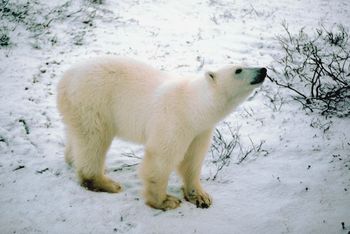Polar Bear Facts
Polar Bear Facts
|
| Interesting Polar Bear Facts: |
|---|
| Male polar bear can weigh up to 1500 pounds and reach 10 feet in length. Females are two times smaller than males. |
| Although they look white, their fur is transparent. When light bounces back from the fur, result is a white color, combination of all colors. Thanks to the white color, they blend with their environment easily. |
| Polar bears have 10 cm thick layer of blubber which keeps them well insulated from low temperature and cold water. Their dense and oily fur keeps them dry even after long time in the water. |
| Although they live in cold environment (temperature can drop below minus 45 degrees of Celsius), they can easily overheat when they run (due to thick fur and blubber). |
| When they run, they can reach 25 miles per hour. |
| They can swim 6 miles per hour. Some polar bears are seen 100 miles away from the shore. They can swim 70-100 miles at once. |
| Polar bears spend most of their time in the water, where they hunt seals (main food source). |
| They have incredible sense of smell and can sense seal on the ice that is 20 miles away. |
| Not all hunting attempts are successful and polar bear shows angry behavior when it loses its prey. Some researchers noted that polar bears break chunks of ice, kick snow or growl when they are disappointed. |
| Like all other bears, they are omnivores (eat both plants and meat). During summer season, bears like to eat berries. |
| Unlike other bears, they don't hibernate. They are active throughout the whole year. |
| They take good care about their hygiene and spend 15-20 minutes in grooming themselves after good meal. |
| Mating season is reserved for April and May. Female gives birth to 1-3 cubs in November or December. She takes care of them in a special "maternity dens" for three months. During that time, she doesn't eat, drink or defecate. |
| Cubs stay with their mother until they reach 2 and half years. Polar bears are slow breeders; they have 5 litters maximally in a lifetime. |
| Polar bears live 15-18 years in the wild and over 30 years in captivity. |
|
Related Links: Facts Animal Facts Animals Facts |

 Polar bears are largest species of bears and largest land predators. They live in Arctic region of Russia, Alaska, Canada, Greenland, and Norway. Due to their large size, they have no natural enemies, except humans. Main factors that negatively affect their survival are global warming and melting of the polar ice caps, pollution of the sea and oil spills. They are on the list of threatened species with only 20 000 animals left in the wild.
Polar bears are largest species of bears and largest land predators. They live in Arctic region of Russia, Alaska, Canada, Greenland, and Norway. Due to their large size, they have no natural enemies, except humans. Main factors that negatively affect their survival are global warming and melting of the polar ice caps, pollution of the sea and oil spills. They are on the list of threatened species with only 20 000 animals left in the wild.